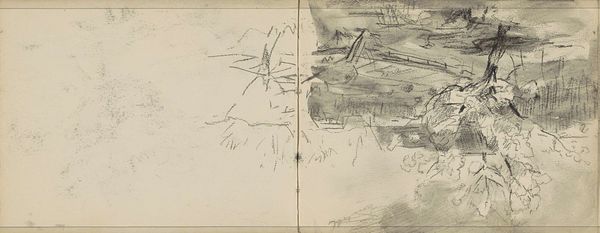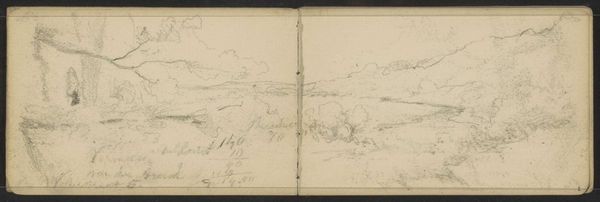
Molen en huizen aan de Vecht, een huis met een rieten dak en een roeiboot 1895 - 1898
0:00
0:00
Dimensions: height 104 mm, width 179 mm
Copyright: Rijks Museum: Open Domain
Curator: This pencil drawing, titled "Molen en huizen aan de Vecht, een huis met een rieten dak en een roeiboot" was created by Willem Cornelis Rip sometime between 1895 and 1898. It depicts, as the name suggests, a waterside landscape in the Netherlands. Editor: It feels immediate, doesn't it? Raw, unpolished. Like a glimpse into a personal moment, a stolen glance. There's something very honest about the simplicity. Curator: Absolutely. Rip’s work emerges during a period when Dutch art was grappling with rapid industrialization and urbanization, a nostalgic embrace of the agrarian. Landscape art was very politically charged and potent, often celebrating the "common" or peasant life against these rising societal forces. Editor: It's interesting how the choice of pencil enhances that sense of immediacy. Compared to paint, it’s far less precious, almost defiant in its rejection of grandiosity, while allowing for detailed realism when applied by a skilled hand. This brings me to consider labor as a factor – the representation of agrarian toil alongside what, undoubtedly, must have been laborious application by Rip himself. What of class here? Is Rip seeking to represent and romanticize those traditionally excluded or othered by bourgeois tastes? Curator: The artistic style of Rip can be seen to emulate or mirror certain features associated with Dutch Golden Age landscapes with elements of Impressionism, where the fleeting effects of light and atmosphere are given prominence and careful attention, albeit not to the level or effect of light and atmosphere produced by other Dutch or French Impressionists. Rip depicts elements as he views them rather than providing commentary of them from any particularly acute viewpoint. In this sense he captures what is there rather than prescribing value. Editor: That rings true. It raises questions, too. This work exists not in isolation but participates within, contributes to, and undoubtedly draws influence from prior works of Dutch Romanticism. There's also the political climate that informed the artist's approach, the landscape depicted itself, and of course how its consumption or analysis may be interpreted or utilized for socio-political agendas. Curator: Exactly. When viewed through that lens, these understated scenes offer so much insight into the cultural and political values of their time, offering the modern observer historical context. Editor: Leaving me with a new found sense of how profoundly intimate the image actually is. Curator: It's a delicate interplay of artistry, historical circumstance, and sociopolitical identity.
Comments
No comments
Be the first to comment and join the conversation on the ultimate creative platform.













